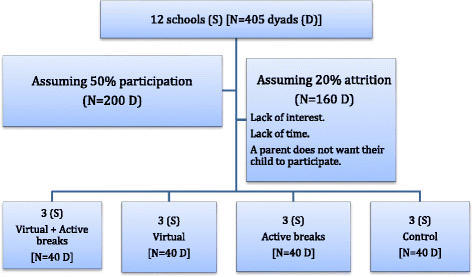Study Protocol of MINI SALTEN: a technology-based multi-component intervention in the school environment targeting healthy habits of first grade children and their parents
- PMID: 28477624
- PMCID: PMC5420097
- DOI: 10.1186/s12889-017-4327-3
Study Protocol of MINI SALTEN: a technology-based multi-component intervention in the school environment targeting healthy habits of first grade children and their parents
Abstract
Background: MINI SALTEN is a program developed to increase moderate to vigorous physical activity (PA) and improve eating habits at home and school in first grade children. It aims to assess the effects of a technology family-based and PA school-based intervention. The purpose of this manuscript is to describe the protocol design and the MINISALTEN intervention.
Methods: This is cluster-randomized controlled trial designed to run from July 2015 to November 2016 in 12 public schools of the city of Buenos Aires, matched for socio-demographic characteristics. The intervention is based on two main components: (a) "active breaks" (AB): implemented during school breaks by a PA instructor; (b) "virtual" (V): web-based contents delivered to the families via a multiplatform application. Using a computer generated random sequence participants are allocated to one of four intervention conditions: (AB), (V), (AB + V), and control (C). Outcomes are measured at baseline and 12 months post intervention, and will include data collected from the child and her/his mother/father or guardian. Primary outcome measures are: PA and sedentary behaviour (measured with accelerometers). Secondary outcome measures related are: percentage of kilocalories (kcal) from added sugars, and from total and saturated fats; grams of fruits and vegetables; and number of snacks and kcal coming from their added sugars and total and saturated fats. Family socio-economic level, home environment, and school environment will also be assessed. Statistical analysis is on an intention-to-treat principle. Baseline characteristics are described using summary measures and mixed models (with school as random effect). The effect of the two interventions will be estimated using a generalized mixed linear model with link and distribution selected according to the type of outcome. Included random effects are: child (or mother/father or guardian) accounting for repeated measures; school accounting for cluster induced by school. The most parsimonious model for each outcome will be reported. The False Discovery Rate criterion will be used to correct for multiple testing in non-planned analyses.
Discussion: It is a pioneer assessment of the impact of a technology-based virtual intervention and a school-based PA program, designed to prevent obesity, and involving the parents at public schools of Buenos Aires.
Trial registration: Current Controlled Trials ISRCTN58093412 . Registered March 14th, 2016 (retrospectively registered).
Keywords: Healthy eating habits; Obesity prevention; Physical activity; School-based intervention; Technology-based intervention; Young children.
References
-
- Guerra PH, Nobre MR, da Silveira JA, Taddei JA. School-based physical activity and nutritional education interventions on body mass index: A meta-analysis of randomised community trials - Project PANE. Prev Med. 2014 - PubMed
Publication types
MeSH terms
Associated data
LinkOut - more resources
Full Text Sources
Other Literature Sources
Medical


